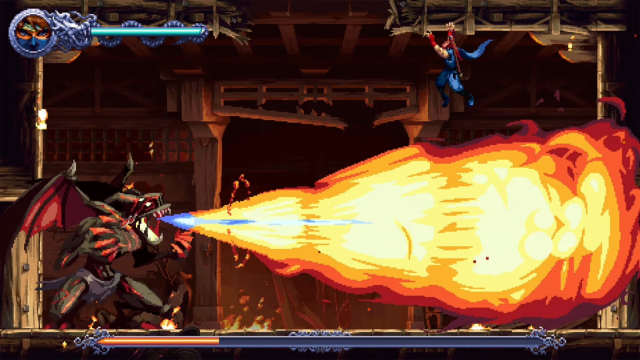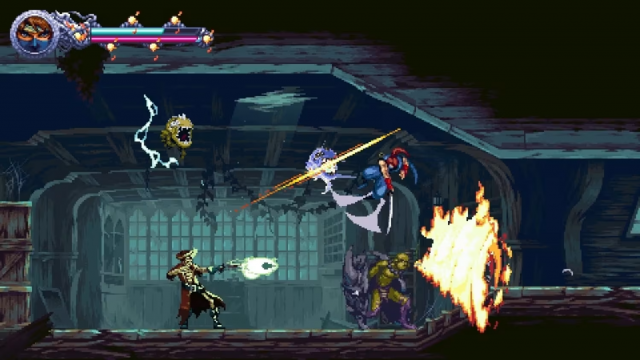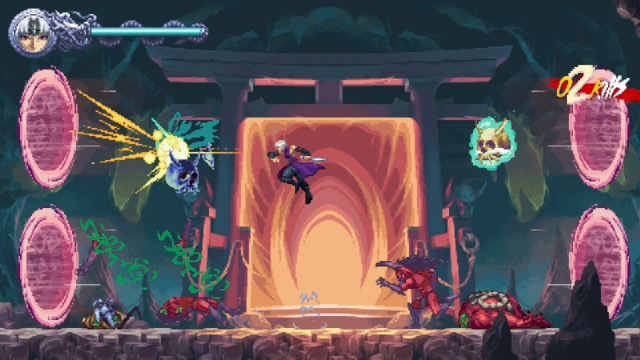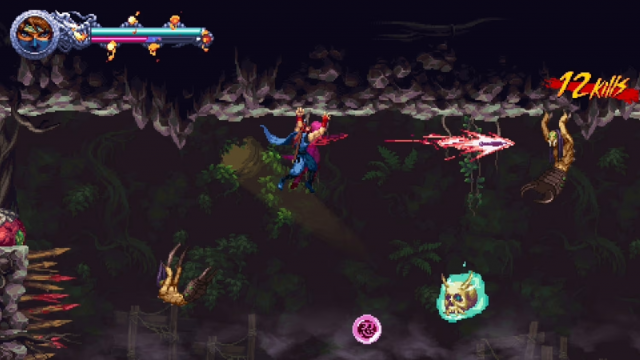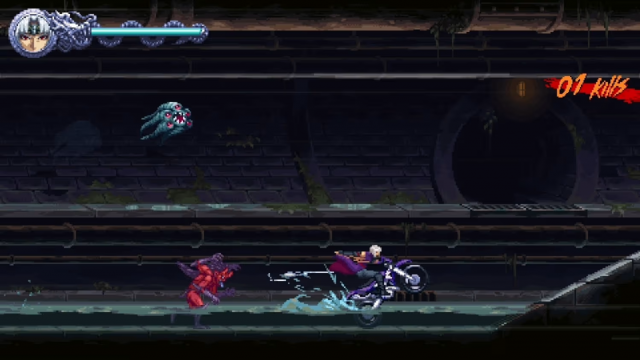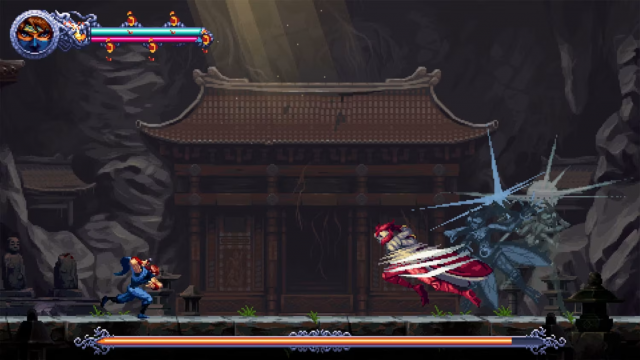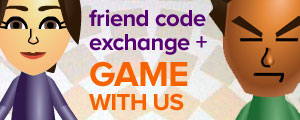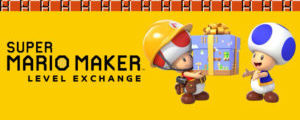When playing Hard mode or going for S-Ranks, a well-tuned and engaging action game; Great visuals and soundtrack; Admirable accessibility options
The well-tuned version of Ragebound requires going out of your way to find Guillotine Boost and overly generous air recovery throw off the balance badly if you don’t care about S-Ranks; Only 30 FPS on both Switch and Switch 2
The “Gaiden” of Ninja Gaiden is supposed to mean “side story,” which has always made the series name a little strange. A side story to what, exactly? Dead or Alive? The original Japanese name was Ninja Ryukenden (roughly “story of the dragon sword”) but was localized as Gaiden simply because that sounded cool, and by the time of the Xbox trilogy, “Gaiden” had willed itself into being the global franchise name just on vibes. It’s ironically the perfect name for a ninja action game, as “because it’s cool, DUH” was the unifying factor of all the nonsensical 80s stories about crime fighting ninjas using ancient Japanese traditions to kick ass and take names in the big city – Frank Miller’s Daredevil, Teenage Mutant Ninja Turtles, Shinobi, The Ninja Warriors, Final Fight, Shadow of the Ninja, and of course Ninja Gaiden all fit this very specific but very common mold. “Gaiden” has never required explanation any more than using katanas to fight a combination of drug dealers, cyborgs, and demon lords. Just as plants instinctively bend towards the sunlight, so do children recognize the innate, undeniable, almost peerless coolness of ninjas. It never had to make sense.
In the Xbox era, Tomonobu Itagaki’s Team Ninja took this fundamental coolness and ran with it right up to the point of self-parody. Ultra-aggressive, ultra-slick, ultra-violent action games, promoted by a celebrity game designer who thought he was cooler than everybody else on earth and let us know it. Why are series hero Ryu’s arms as thick as his legs? Why is the female demon hunter dressed in bondage gear? Why are we fighting a tank using a bow and arrow? Doesn’t matter, NERD.
Only at the end of its third decade and long after Itagaki’s departure has the series finally acquiesced to making sense and produced an actual Gaiden. NINJA GAIDEN: Ragebound tells the story of what the rest of Ryu’s clan was dealing with back in Japan while Ryu was stateside on the trail of his father in 1988’s NES original. It’s a clever and humble premise, tying into the long-dormant series history without threatening to usurp it. Unlike all of the previous major releases, which were produced internally by Tecmo, Ragebound was made by an external team, the Spanish indie studio The Game Kitchen, which previously made Blasphemous and its sequel.
The Game Kitchen makes a lot of sense as a steward for 2D Ninja Gaiden. The Blasphemous duology combines top-tier pixel art, high quality boss fights, and a bracing level of challenge. Although these games are Metroidvanias, they have more methodical enemy placements, reminiscent of classic (pre-Symphony) Castlevania games, and they feel more solidly and antagonistically designed than most in the genre. And with the original Castlevania being the main inspiration/template for the original NES Ninja Gaiden, there was a lot of reason to be hopeful for The Game Kitchen’s success in turning in a great Ninja Gaiden-style game too.
What The Game Kitchen has produced here is not a straight repeat of the classic Ninja Gaiden formula. Protagonists Kenji and Kumori have been tuned to be more lethal in motion, and to have greater aerial mobility, bringing to mind other ninja franchises like Strider and Shinobi, and also more recent ninja throwback games like The Messenger with its Cloud Step mechanic, which let the player chain multiple jumps without touching the ground. And there are influences from the Xbox trilogy as well, with the Hypercharge mechanic (banking power by killing some enemies and then spending it to shred others) specifically echoing the Ultimate Technique moves from those games.
The small delay between earning a Hypercharge and being able to spend it is a very wise decision that I think reveals the care that went into playtesting this game, at least on the higher difficulty. On paper this seems like it would be very easy to accidentally spend a Hypercharge prematurely by rapidly slashing an enemy, but in practice I found that basically never happened. The fact that the only way to store a Hypercharge but still attack is to use the Guillotine Boost (see below) is also a satisfying quirk of the combat system. That’s limiting and low damage but still lets you eliminate some threats while getting into position to take out a priority target. Good stuff.
Many elements of Ragebound very clearly work. It’s gorgeous, the soundtrack is a superb mix of new compositions and remixes of old favorites like Unbreakable Determination and Requiem (A Hero’s End), the controls feel great, and the bosses are up to The Game Kitchen’s high standards. Once the game has been properly configured (more on that below), the pacing is also great, moving straight from one engaging set piece to another, without any gimmicks or noninteractive segments that drain the fun on replay (like repeatedly waiting for a laser to fire in the largely excellent Cyber Shadow). Even things like the elevator mini-cutscenes in stage two are skippable. That’s a level of player consideration uncommon in modern games that try to pay homage to the arcade era. The rest of the game largely works and is ultimately highly recommended, but with caveats.
Ninja Gaiden is, to put it lightly, a series with a reputation. The original NES game is probably the first thing that comes to mind when people describe 8-bit games as “Nintendo hard,” with a lot of highly adversarial enemy placements, bottomless pits Ryu is eager to leap into at only the slightest avian provocation, and an infamously nasty three-phase final boss that kicks the player all the way back to the start of the stage on death. The Xbox trilogy has an even more imposing reputation, and even among aficionados of its genre, Ninja Gaiden’s enemies feature infamously bloodthirsty AI, with combat being about as quick, brutal, blood-slicked, and stressful as the medium has produced. Ragebound has serious shoes to fill.
The weird thing is that Ragebound can live up to the legacy of its forebears, but the game is inexplicably sheepish about it. Like the Xbox Ninja Gaiden games, the game features a higher difficulty option. Unlike those Xbox titles, Ragebound does not let you select that higher difficulty until after completing the game on the Normal difficulty, and that Normal difficulty is really too easy. Its tuning is baffling given that the difficulty of the series is and always has been its main selling point, so much so that it was the Dark Souls of video game difficulty discourse before Dark Souls. It’s even more baffling given the game’s copious and admirable accessibility options. Why is it so easy? You can reduce the damage Kenji takes (and it’s honestly very low to start with), can remove the knockback you get when Kenji is hit by an enemy (even though Kenji already has very generous air recovery options), and you can reduce the game’s speed as desired just like in Celeste. The accessibility options mean that the game ships with an almost infinite array of extra-easy modes, but if you want to make a Ninja Gaiden game actually hard? You have to ask nicely and put in the work.
And it’s not just that the enemy formations are relatively simple on Normal or that they don’t do much damage. It’s that these facts are on top of Kenji’s very generous toolkit for avoiding enemies altogether. He has an evasive dash that lets him phase through enemies, which is very low risk given how little damage he takes if you mess up the timing or don’t see a projectile coming. On top of that, this game features a Cloud Step-style mechanic called the Guillotine Boost, which visually calls back to the NES original’s spin slash technique and is basically like the pink bullet parry in Cuphead if everything in Cuphead was made of pink bullets. It’s very empowering and fits well into combat, unless the player decides that they’d rather not engage with a screen of enemies, at which point they can often just bounce, bounce, bounce their way past the danger. Want to turn away from the way of the blade and float past your problems like Kirby instead? Have I got the ninja game for you.
There’s room in gaming for experiences that are primarily breezy or empowering, of course, but it’s a poor fit for Ninja Gaiden. I realize this all sounds damning (“easy Ninja Gaiden” is a pitch that completely misunderstands the audience), but a couple of things do significantly mitigate the above issues.
First, every stage in the game has a built-in rank system, which gives the player feedback and incentives to actually engage with the game’s mechanics. You try to clear the stage in a low enough amount of time, killing a high enough number of foes, including killing a high enough number of them in an unbroken chain, all while collecting various half-hidden items and completing some stage-specific challenges along the way. When you’re not jumping over enemies or damage-skipping through them and are instead trying to singlehandedly take down the hordes of Hell, the game honestly starts to put up a fight and the stage design clicks. You just have to care enough to do that.
Second, early on the game will unlock a system of equipable talismans which will let you augment Kenji and Kumori’s abilities in various ways. You will also acquire some challenge talismans which make the duo weaker in exchange for earning higher ranks. And once you do both of these things – equip the challenge talismans and seriously try to S-Rank stages – the game’s design really works. Every enemy feels threatening when you take triple damage or can’t rely on finding healing items, and stage segments start to reveal an engaging flow. Once you graduate to Hard mode, the full quality of the game really comes clearly into view… which is why the fact that you have to complete the game on Normal first is so hard to accept. But it is what it is. Perhaps The Game Kitchen made the game default to being so easy because they were worried that those reviewers who were bad at action games would still fall into pits, get frustrated at their own skill level, and hold it against the game. Perhaps they really didn’t foresee the stage-skipping issues with the Guillotine Boost. Or perhaps they just wanted to facilitate the fantasy of being a ninja buzzsaw without the skill requirements of the other Ninja Gaiden games. This breezy form of Ragebound is still fun in a turn-off-your-brain-and-chill kind of way, but it really sells the game short.
As an aside, the game’s frame rate on Switch (30 FPS, even on Switch 2) has been much-discussed and is very unfortunate. Given Blasphemous had no issues hitting 60, it is unexpected. Setting aside the question of where to lay the blame or when it might get fixed, let’s consider the question of whether the lower frame rate is enough of a problem to advise against buying the game on Switch. I don’t think it is. It’s a fast paced game but it’s not that fast, and doesn’t depend on twitch reactions to the extent that an extra few milliseconds will make or break your chances in combat.
What of the titular Gaiden, the story on offer? Setting aside difficulty tuning defaults, this is actually the one area in which I feel Ragebound really does not compare well to Blasphemous. Blasphemous obviously has a more detached, enigmatic, and Souls-ish style of storytelling, but it’s well-executed and features reliably fascinating cutscenes. Ragebound is more plain in every sense, featuring two anime-ass protagonists (Ryu’s clan compatriot Kenji, and Kumori of the Dragon Clan’s mortal enemy, the Black Spider Clan) who are magically bound together and then bicker like siblings in between heroics. It’s completely serviceable, but that’s about it. It’s easy to forget, but the NES trilogy featured impressive and groundbreaking cinematic cutscenes unlike anything else on the system, as visually arresting for the time as those in, oh, let’s say Blasphemous. Ragebound’s cinematics are much more paint by numbers, unfortunately.
This requires stressing because it’s distressingly easy to miss, so let me reiterate: there is a very high quality action game hiding behind just these few tweaks. If you are the kind of player who just finds the path of least resistance to the end of the game and then shelves it, you’re not going to get much from Ragebound aside from the bosses and the aesthetic. If you are willing to instead get under the hood, engage with the rank system, and maybe equip a challenge talisman or two, on the other hand, Ragebound can be a hell of a ride, and on these terms it has been one of my favorite games of the year.
This review is part of our Year of the Ninja celebrations where we recognize the thrilling comeback of the ninja game and honor the impact these titles have had on the history of the video game industry. To learn more, click here.




 ShareThis
ShareThis